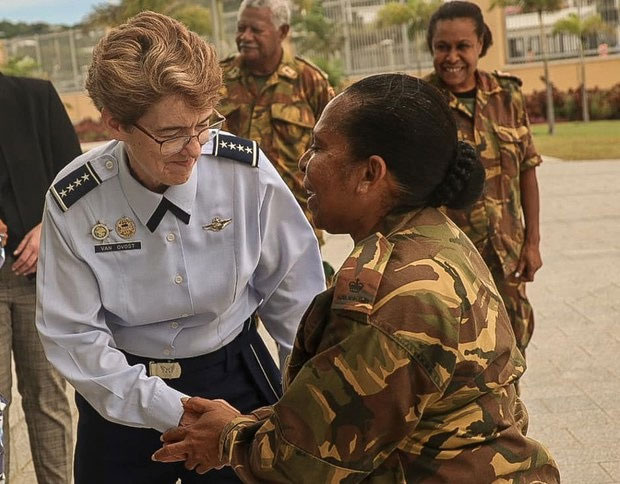
In this photo published by the U.S. embassy in Port Moresby, Commander of the U.S. Transportation Command, Gen. Jacqueline Van Ovost, greets a member of Papua New Guinea’s Defense Force in Port Moresby during a December 2023 visit to the Pacific island country.
US upgrades to military infrastructure in Papua New Guinea to span several years
Cooperation could improve Papua New Guinea’s capacity to respond to frequent natural disasters.
By Stephen Wright, Radio Free Asia
December 20, 2023
The U.S. military’s transportation command has assessed port and airport infrastructure in Papua New Guinea for upgrade over several years under a defense cooperation agreement between the superpower and the most populous Pacific island nation, its commanding general said.
The United States and Papua New Guinea signed the defense pact in May that critics have said impinges on the Pacific island country’s sovereignty. In August, just days after the U.S. State Department said the agreement had come into force, Papua New Guinea’s opposition leader sought a Supreme Court review of whether it is consistent with the country’s constitution.
“We’ve had an opportunity to assess some of the infrastructure and we had discussions on how we would be able to support that development, out fully, of that infrastructure, so that they can achieve their goals for the region,” Gen. Jacqueline Van Ovost told reporters on Tuesday.
“We discussed how we work together to modernize the existing infrastructure over the next several years.”
Van Ovost, commander of the branch of the U.S. forces responsible for the logistics of war and disaster relief contributions, visited Papua New Guinea last week – part of a recent U.S. focus on the Pacific region in response to China’s inroads with some island states.
Her comments emphasized the boost defense cooperation with the U.S. would give to Papua New Guinea’s capacity to respond to natural disasters. The country of more than nine million people is prone to earthquakes and volcanic eruptions because of its location on the Pacific Ring of Fire. Its defense force personnel number only about 4,000.
Papua New Guinea is committed to “expanding their humanitarian assistance disaster relief capability and to developing that resilient infrastructure we talked about so that they could have a fast response either for their own people or for others in their region,” Van Ovost said. “They want to be a leader in doing this.”
The 15-year defense agreement allows for unrestricted U.S. use of six sea and air ports in Papua New Guinea, including the capital Port Moresby’s airport and seaport, the Lombrum Naval Base and the airport and port at Lae, an industrial center.
The U.S. has sought to bolster its already significant military presence in the Pacific and East Asia in response to China’s claims to the South China Sea that impinge on several Southeast Asian countries’ waters, its belligerence towards Taiwan – which Beijing considers a rebel province – and other activity.
Aside from Papua New Guinea, the U.S. has strengthened its defense ties with the Philippines, which is embroiled in territorial disputes with Beijing in the South China Sea.
The U.S. and the United Kingdom are also working to equip Australia with nuclear-powered submarines by next decade under the AUKUS pact – another source of concern for some Pacific island nations that fear being dragged into superpower competition.
China’s military spending has grown rapidly for the past two decades but remains dwarfed by that of the U.S., which also has hundreds of military bases around the world.
Van Ovost, responding to a question from a journalist in Indonesia, said there is no territorial ambition or threat to other nations involved with the U.S. military expansion in Papua New Guinea. The Pacific country has a 760-kilometer (472-mile) border with Indonesia, which overshadows Papua New Guinea in population, economic size and military strength.
She said the agreement deepens the U.S.-Papua New Guinea relationship and also gives Papua New Guinea the ability to achieve its national security goals.
